Effective Engineering Teams
November 9, 2023
tl;dr: Google research found that psychological safety is the most important dynamic for an effective team. This was alongside other dynamics like dependability, role clarity, meaningful work and impact.
The following is a write-up on effective teams based on Google's Project Aristotle. It refers to insights we originally published on Re:Work which I cover in Leading Effective Engineering Teams.
At the heart of Google's productivity are teams. Teams are where ideas take shape, work unfolds, and team members engage with their tasks. Yet, they're also a breeding ground for interpersonal challenges and ambiguous objectives, all of which can disrupt your team's workflow.
In the wake of Google's Project Oxygen research insights on managerial excellence, Google embarked on another large research effort - Project Aristotle - to understand the makeup of an effective team. Named after Aristotle's adage that "the whole is greater than the sum of its parts," this initiative aimed to harness the collective prowess of Google's workforce.
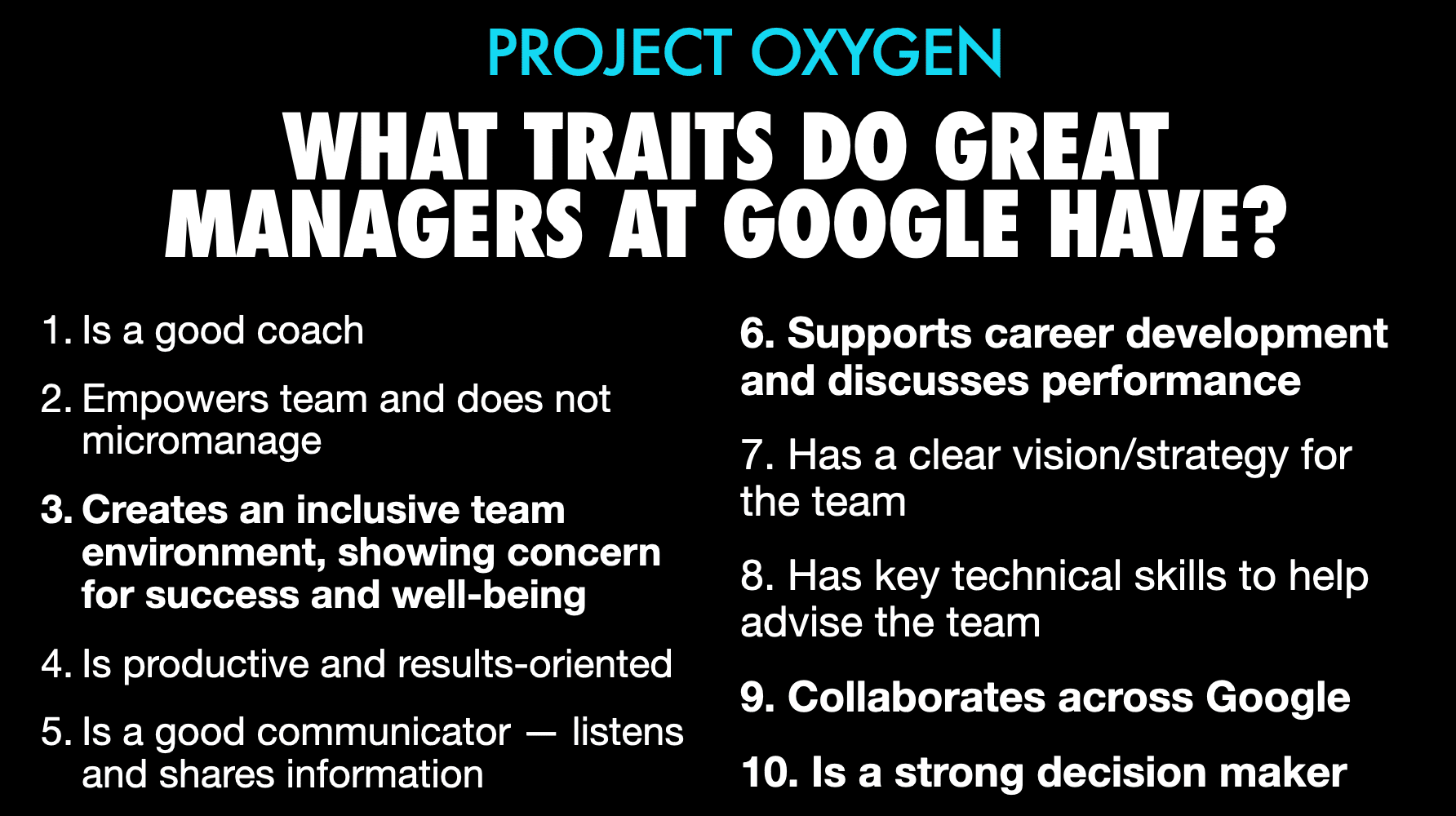
"What Google Learned From Its Quest to Build the Perfect Team" goes into more detail on the study.
Defining a "Team"
To understand what elevates a team at Google, we must first define what a "team" is. This is about understanding the roles, relationships, and responsibilities that characterize a team's effectiveness.
A "work group" and a "team" may seem interchangeable, but they differ fundamentally in their degree of interdependence:
Work Groups: Operate with minimal interdependence and are often a product of organizational hierarchies. Their interactions are typically limited to information sharing during occasional meetings.
Teams: Thrive on interdependence. They collaborate intensively - planning, solving problems, making decisions, and evaluating progress - to achieve specific project goals.
Recognizing that organizational charts don't capture the full picture, Google's researchers focused on entities with genuine interdependent connections, as identified by the teams themselves.
Defining "Effectiveness"
What metrics determine a team's effectiveness? Traditional measures - like lines of code or bug fixes - proved insufficient. Leaders realized these metrics could be misleading; more code isn't inherently better, and more bug fixes might indicate more initial errors.
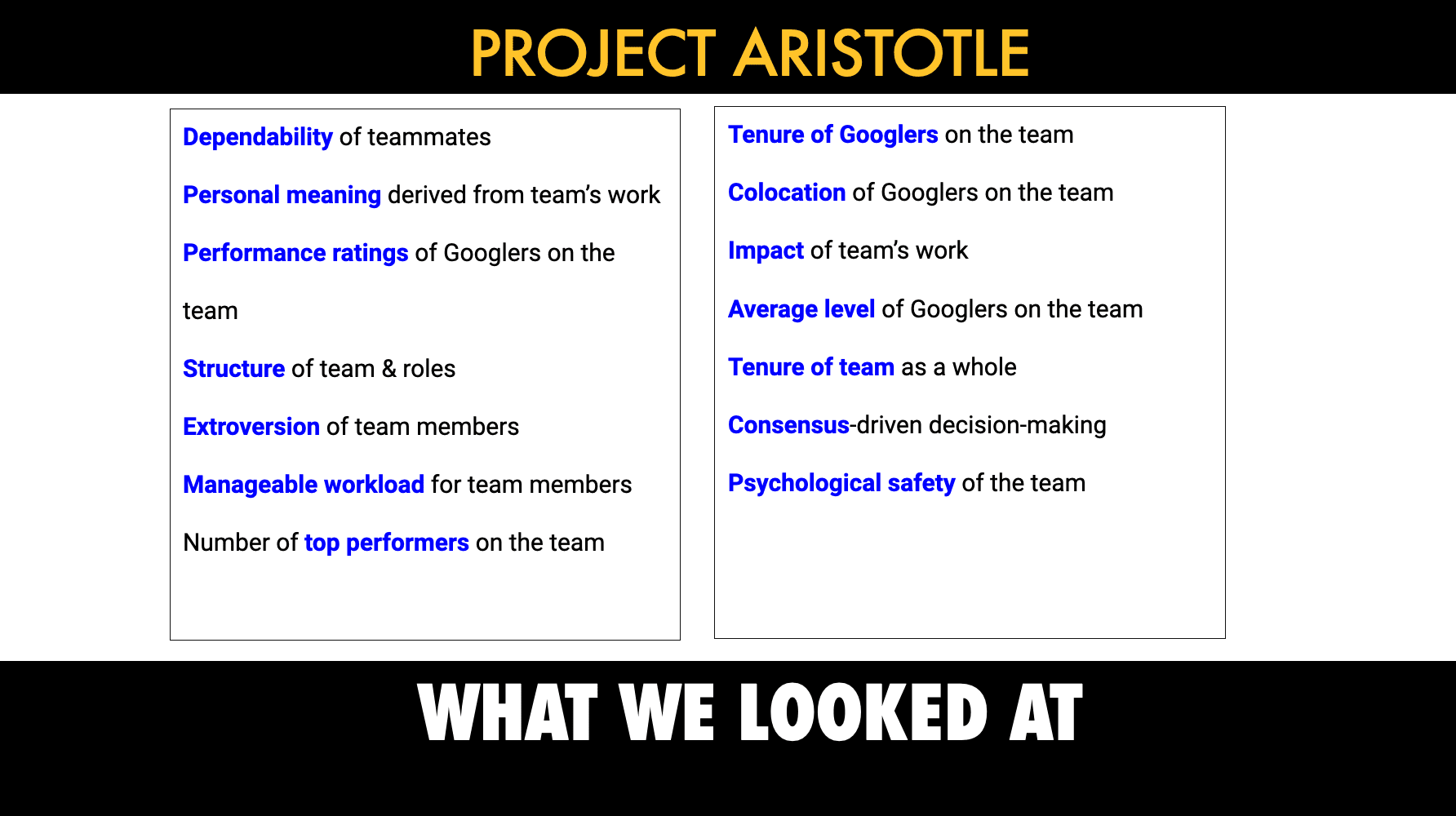
Thus, Google combined qualitative assessments from executives, team leads, and team members with quantitative data, such as:
- Executive evaluation of the team
- Team leader evaluation of the team
- Team member evaluation of the team
- Sales performance relative to quarterly goals
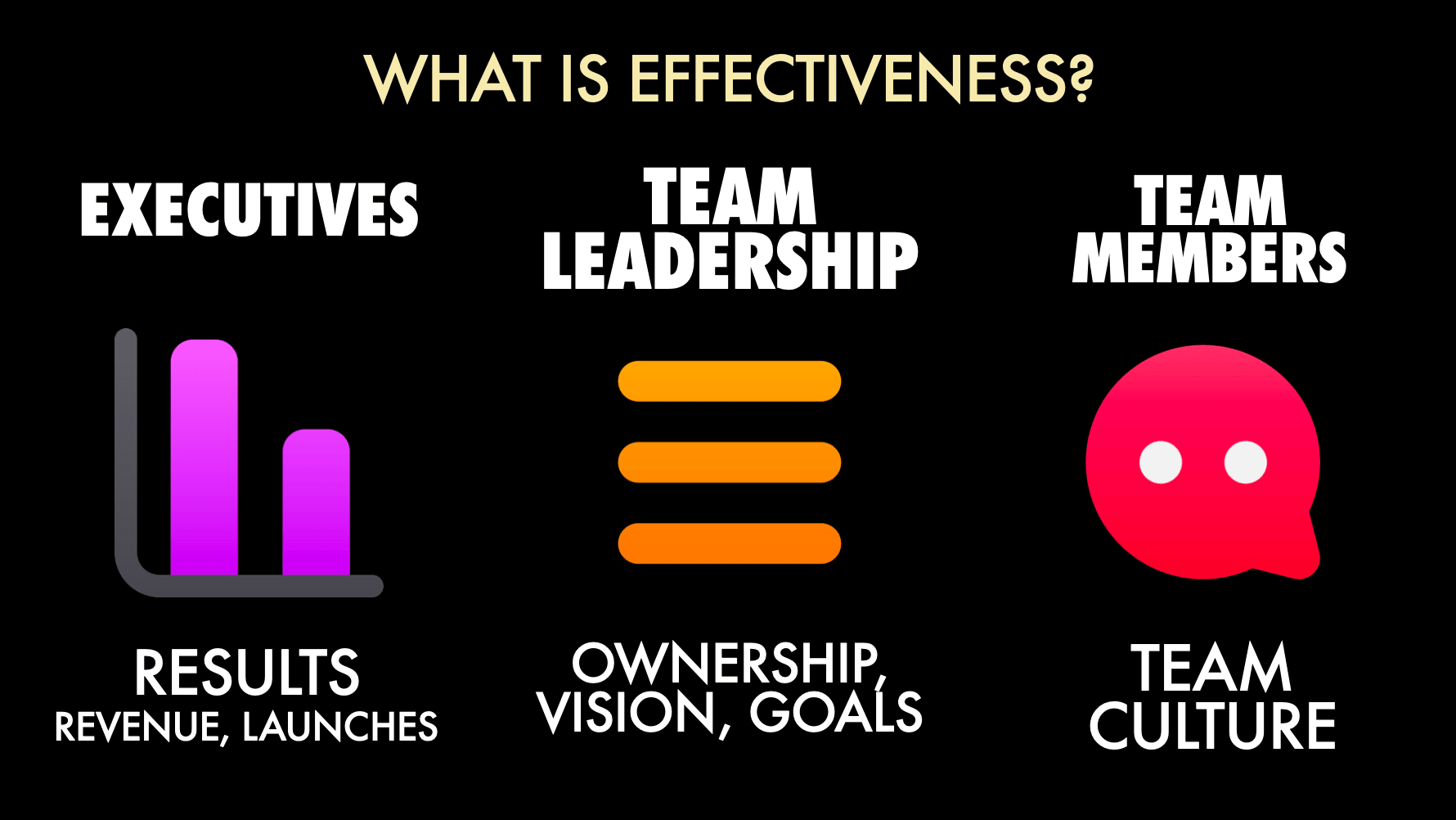
Executives focused on tangible outcomes, such as revenue figures or product rollouts. In contrast, team members highlighted the significance of a positive team environment as the true gauge of effectiveness. Bridging these viewpoints, team leads emphasized the importance of ownership, clarity of vision, and clearly set objectives.
These evaluations allowed for a richer, albeit subjective, picture of effectiveness, balancing out the concrete but context-blind quantitative data.
Collecting Data and Measuring Effectiveness
The Project Aristotle study encompassed 180 diverse teams, aiming to parse out how team composition and dynamics influence effectiveness.

Researchers drew from existing studies and Google's own data, probing variables like:
- Group Dynamics: Openness to divergent opinions
- Skill Sets: Ability to overcome obstacles
- Personality Traits: Reliability
- Emotional Intelligence: Empathy
Alongside, demographic details such as tenure and location were also considered.
Identifying Dynamics of Effective Teams
Data analysis illuminated that a team's success hinged less on who was in it and more on how its members interacted. The Google researchers found that individuals on teams with higher psychological safety are less likely to leave, they’re more likely to harness the power of diverse ideas from their teammates, they bring in more revenue, and they’re rated as effective twice as often by executives.
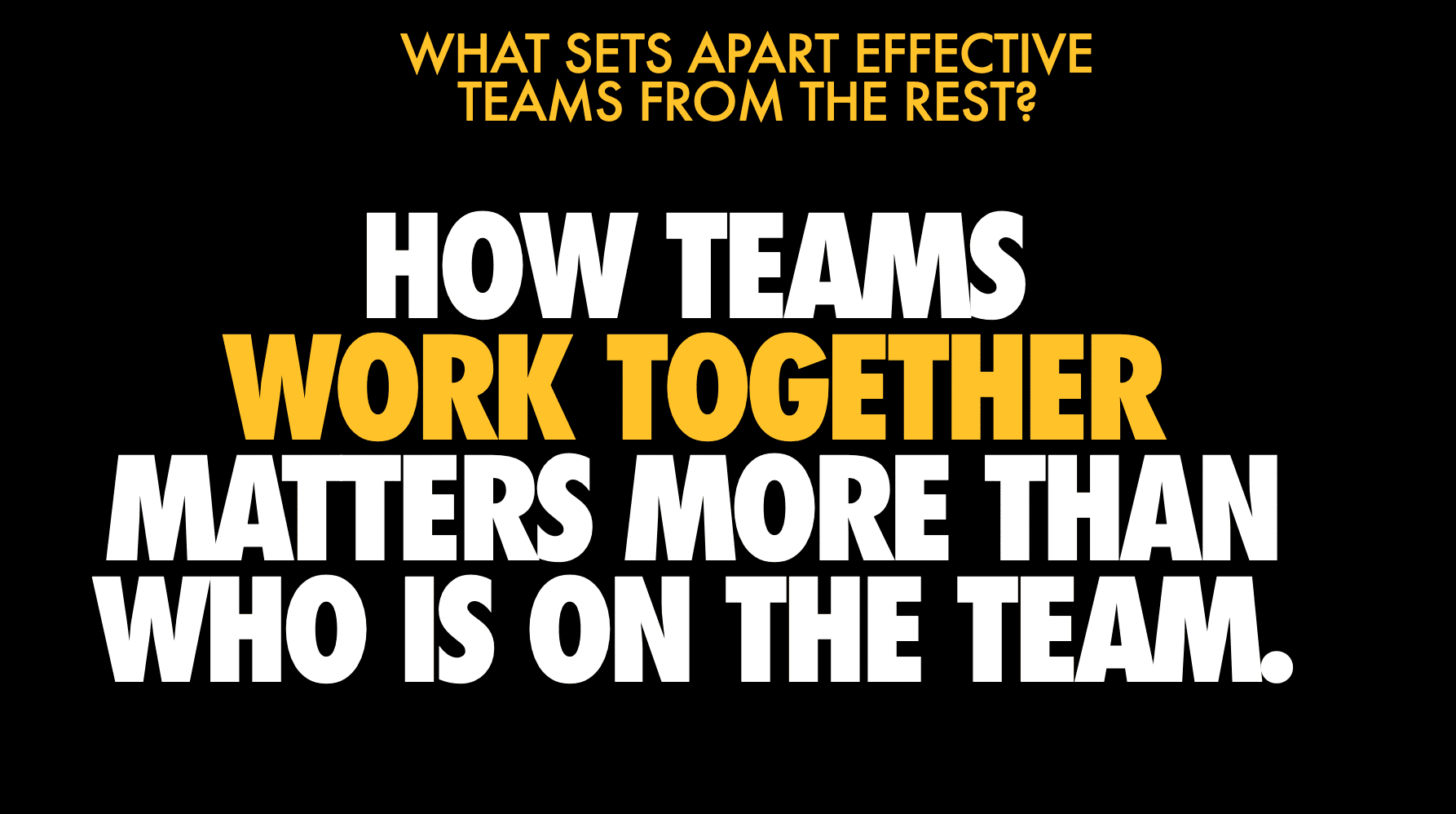
Key factors included:
- Psychological Safety: The team's comfort with taking risks without fear of negative repercussions.
- Dependability: Team members' ability to reliably deliver quality work on schedule.
- Structure and Clarity: Clear understanding of job roles, processes, and performance consequences.
- Meaning: The personal significance found in the work or its outcomes.
- Impact: The belief that one's work meaningfully contributes to the organization's goals.
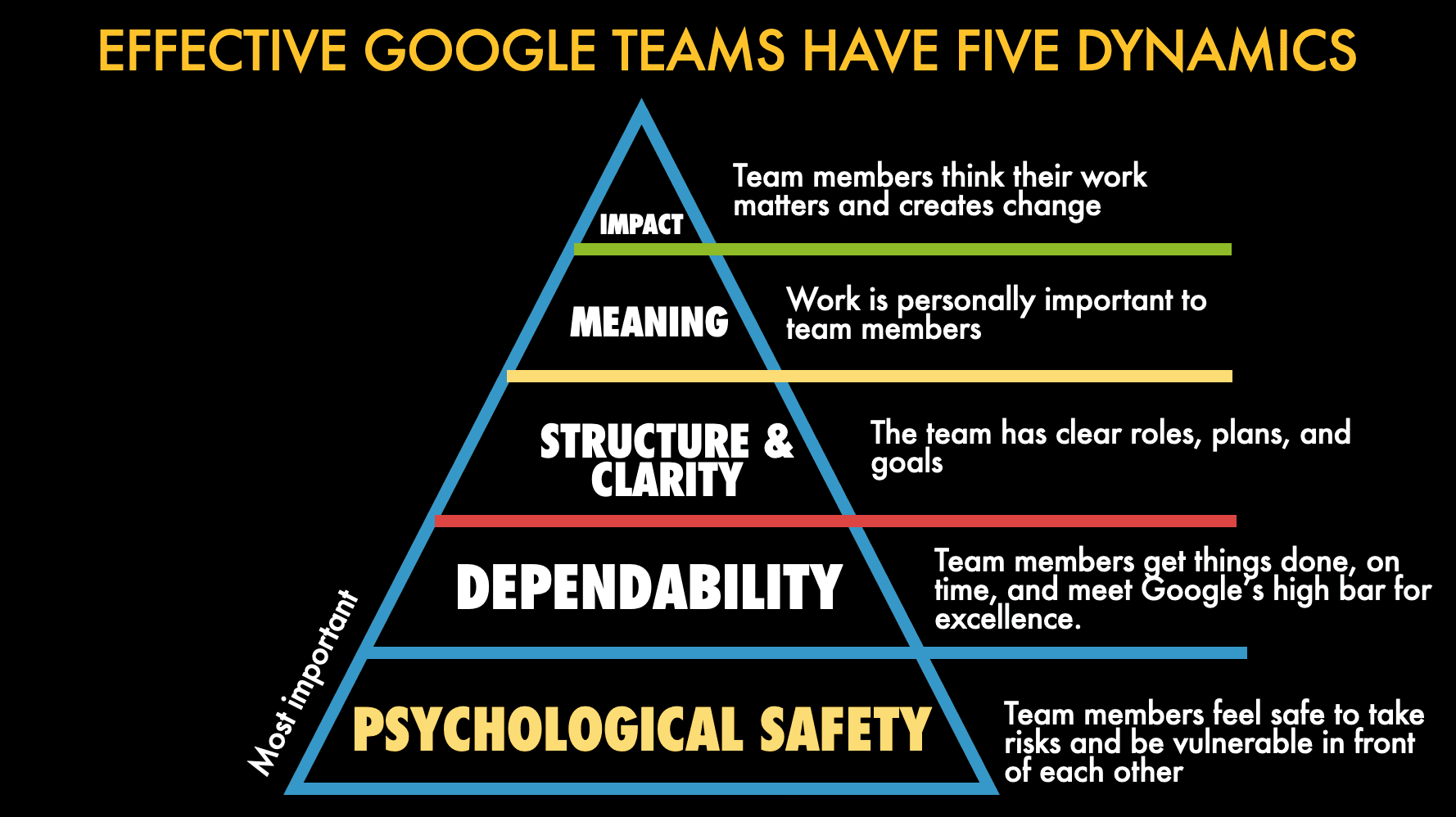
Let's dive into this in more detail. Upon analyzing a large number of data points, the investigative team employed more than 35 distinct statistical models to parse through hundreds of variables. Their aim was to discern patterns that influenced team effectiveness in manifold ways. They looked for factors that:
- Affected multiple outcome metrics, encompassing both qualitative perceptions and quantitative results.
- Were prevalent across diverse teams, regardless of their functions within the organization.
- Demonstrated a strong and consistent pattern of statistical significance, suggesting a reliable influence on team effectiveness.
The insight derived from this comprehensive analysis indicated that team effectiveness was fundamentally influenced not by the identities of team members but by the nature of their collaboration. Highlighted below are the critical dynamics, ranked by their impact:
Psychological Safety
Psychological safety emerged as the cornerstone of effective team dynamics.
This pertains to a team's collective comfort in embracing vulnerability - where members feel insulated against ridicule or retribution for voicing their ideas, questions, or concerns. High psychological safety enables individuals to propose innovative solutions or admit errors without fear, fostering an environment ripe for growth and learning.
Dependability
Teams that were marked by dependability consistently delivered high-quality work within established timelines. This dynamic hinges on the reliable performance of each member, contributing to the team's collective success and sidestepping the pitfalls of missed deadlines or unmet obligations.
Structure and Clarity
A team's understanding of job roles, processes, and performance consequences underpins its ability to function effectively. Clarity about what is expected, how one should proceed, and the implications of one's work contributes to efficient goal attainment.
Google harnesses Objectives and Key Results (OKRs) to demarcate and communicate objectives, emphasizing specific, challenging, and achievable goals.
Meaning
Team members who find their work meaningful are more likely to contribute to a team's success. This meaning can take various forms: financial stability, familial support, the success of the team, or personal expression. When team members perceive their tasks as significant, their engagement and productivity soar.
Impact
Recognizing the significance of one's contributions to the broader organizational goals underlines the importance of impact. The acknowledgment that one's efforts are not in vain but instead play a crucial role in the organization's triumphs is a powerful motivator for team members.
Factors With Minimal Impact at Google
Interestingly, certain variables that might intuitively seem linked to team effectiveness did not hold statistical significance within Google's framework:
- Colocation: Physical proximity of team members.
- Consensus-driven decision-making: Teams that strive for unanimous agreement.
- Extroversion of team members: The outward sociability of individuals.
- Individual performance: Assessing team members on isolated accomplishments.
- Workload size: The amount of work assigned to a team.
- Seniority: The tenure or rank of team members within the organization.
- Team size: The number of individuals comprising a team.
- Tenure: The length of time team members have spent within the team or company.
While these factors did not heavily influence team effectiveness at Google, their significance may vary in different contexts. For instance, literature suggests that smaller teams, generally those with fewer than ten members, can outperform larger ones, potentially offering better work-life balance, outcomes, communication, and cohesion, which are essential components of team success in numerous studies outside of Google's specific environment.
Survey: How Teams Can Identify Their Unique Dynamics
The Google research team knew that sharing their findings wasn't enough; they wanted each team to have the tools to explore their particular dynamics and improve upon them. To do this, they developed a reflective survey rooted in the five pillars of team effectiveness. The idea was simple yet powerful: create a conversation starter that allows teams to self-assess and spark dialogue about their collective practices and behaviors.
Here's what that looked like:
- Psychological Safety: "On our team, making a mistake is seen as an opportunity to learn rather than a blunder to be penalized."
- Dependability: "I can count on my teammates to deliver on their promises and commitments."
- Structure and Clarity: "We have a clear and effective roadmap for decision-making within our team."
- Meaning: "The work I contribute to the team holds personal significance for me."
- Impact: "I can clearly see how our team's efforts make a difference to the broader goals of the organization."
Upon completing this survey, team leads would receive scores that, while anonymous, provided a clear snapshot of where the team stood on these pillars. With these insights, teams could come together, led by a facilitator or guided by a carefully designed discussion framework, to have open, honest conversations.
A Google Doc copy of the discussion guide can be found here
These discussions weren't about pinpointing flaws but were designed to celebrate strengths and identify opportunities for growth - the kind of conversation that leads to real, tangible improvements in how a team functions. It's about giving teams the lens to look at themselves critically, understand where they excel, and where they have room to evolve.
Building a Culture of Psychological Safety
As noted earlier, at the heart of the most effective teams is a foundation of psychological safety – a term that echoes significantly through the corridors of Google. This crucial element outranked all others in the company's comprehensive research on team dynamics.
In a psychologically safe environment, team members feel comfortable taking risks and expressing their thoughts without the fear of ridicule or rejection. This mindset isn't just about keeping team members content and productive; it helps drive the company forward too. When teams feel safe, they may stay longer, tap into a diverse pool of ideas, boost revenue, and double their odds of being recognized for their effectiveness by leadership.

Amy Edmondson, a renowned Harvard scholar, originally coined "team psychological safety" and described it as the collective confidence of a team to take interpersonal risks without fear of embarrassment or punishment. While it may sound trivial, the reality is that asking a seemingly basic question or admitting a mistake can be daunting – the kind of daunting that can lead to critical misunderstandings or missed opportunities.
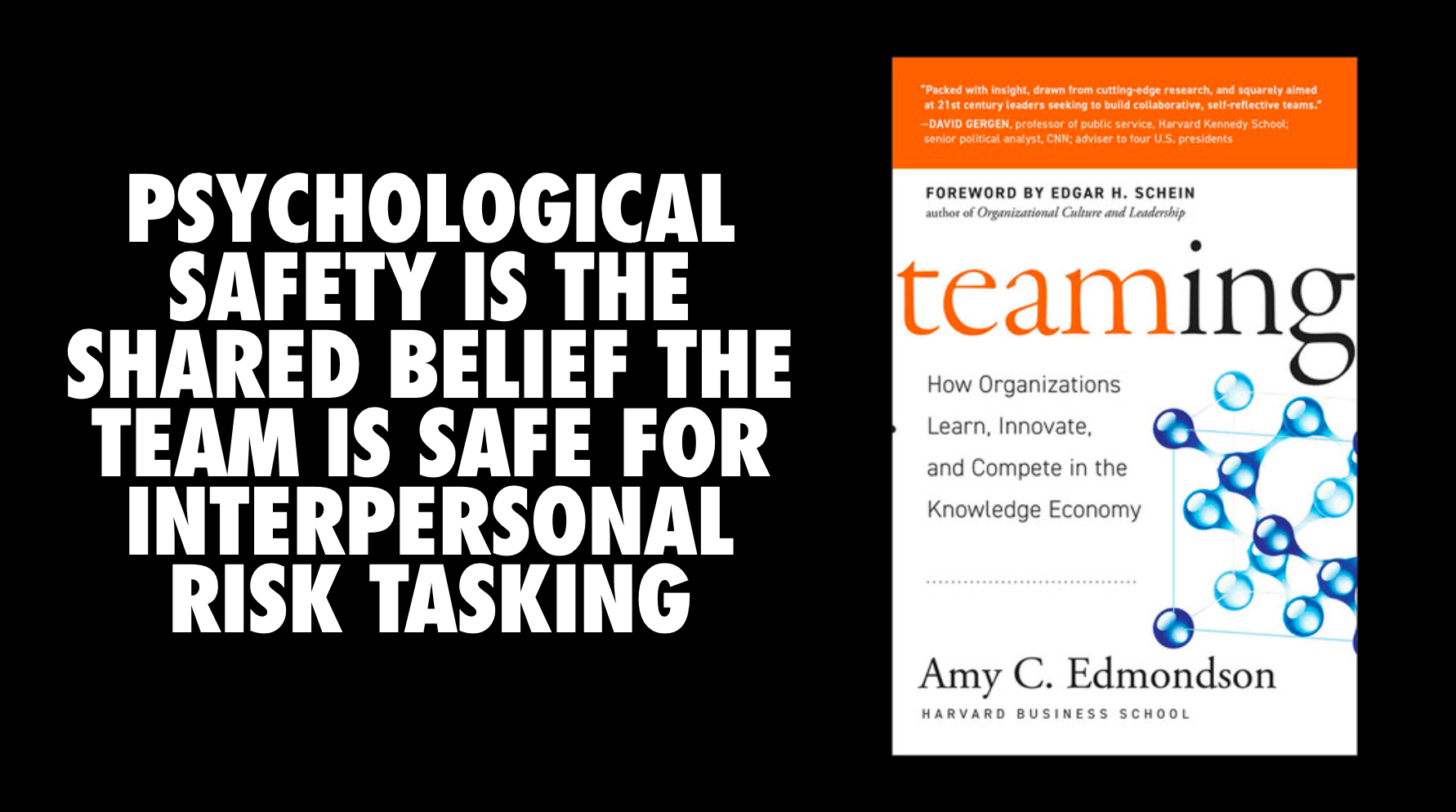
To get a real pulse on psychological safety within a team, Edmondson crafted statements that asked team members to reflect on their experiences:
- "Making mistakes here is often held against you."
- "We can talk about tough issues."
- "Being different isn't fully accepted."
- "It's safe to take risks."
- "Asking for help is difficult."
- "No one will undermine my efforts."
- "My unique skills are valued."
In her TEDx talk, Edmondson shares three actionable steps anyone can take to cultivate this safety:
- Treat work as a learning process, where problems are solved through trial and error, not just by executing on known procedures.
- Admit your own mistakes – it's a powerful way to open doors for others to contribute and take risks.
- Be inquisitive. Ask questions to spur a culture of exploration and discovery.
To bring these concepts to life within Google, the research team has hosted interactive workshops. They use anonymized, real-world examples to dissect and understand behaviors that promote or undermine psychological safety.
Here’s a scenario they might have used:
Scenario: Uli, a seasoned manager with a technical edge, has led team XYZ for two years. Renowned for his high standards, Uli's tolerance for errors and new ideas has waned. Recently, he openly criticized a team member's suggestion, which was otherwise seen as innovative by the rest of the team. Since then, the flow of ideas has stopped. Uli's concepts dominated the latest project proposal, which was turned down by the executives for its lack of creativity.
Debriefing Points:
- Identify actions that either support or hinder psychological safety.
- Discuss the impact of psychological safety on team performance.
- Share personal observations or experiences related to psychological safety in your own teams.
For managers, embracing these principles is paramount. Your approach to leadership can either build a fortress of trust and innovation or erect walls of hesitancy and silence. Remember, fostering psychological safety is not about lowering standards, but rather creating an environment where people can meet those standards through collaboration, openness, and mutual respect.
Manager actions for psychological safety can be found here
Conclusions: Actionable Insights from Google's Project Aristotle
Understanding Team Dynamics
Google's Project Aristotle delves into the core of what elevates a team's performance. This journey into understanding isn't confined to the tech halls of Google but is applicable whether you're brainstorming the next bestseller, gearing up for an interstellar mission, or strategizing for the next big game. Recognizing the essence of an effective team, Google is now navigating the next phase: applying these insights to nurture and sustain high-performing teams.
Your team's formula for success may diverge from Google's findings, but these principles can guide any organization in enhancing team effectiveness:
1. Establish a Common Language
- Create Definitions: Craft clear definitions for the team behaviors and standards you aspire to achieve within your company.
2. Foster Open Dialogue
- Encourage Conversations: Facilitate discussions on team dynamics in a secure and positive environment. Bringing in an HR Business Partner or a seasoned facilitator can add value.
3. Engage Leadership
- Model Behaviors: Secure commitment from the top. When leaders exemplify and constantly refine these behaviors, it cements the organizational culture.
Strategies for Leaders and Managers
The following strategies, informed by Google's findings and corroborated by external research, can support managers in cultivating these five critical team behaviors:
For Psychological Safety:
- Encourage participation by asking for everyone’s ideas and opinions.
- Share your personal work styles and encourage your team to do the same.
- Watch and discuss Amy Edmondson's TED Talk on psychological safety with your team.
For Dependability:
- Clearly outline who is responsible for what.
- Create detailed project timelines to give visibility into each person’s contributions.
- Dive into the research on conscientiousness and its impact on team performance.
For Structure and Clarity:
- Keep everyone aligned on team objectives and review the progress regularly.
- Run meetings with a clear agenda and appoint a facilitator.
- Implement Objectives & Key Results (OKRs) to streamline the team's targets and tasks.
For Meaning:
- Recognize individual contributions and offer support where it's needed.
- Show gratitude publicly for team members who lend a hand.
- Explore the KPMG case study on cultivating a sense of purpose at work.
For Impact:
- Co-develop a vision that connects individual efforts to the team's and organization's goals.
- Reflect regularly on the direct impact of your team's work on customers or clients and the organization.
- Adopt a user-centered approach to evaluating success, focusing on the people you're serving.
By integrating these approaches, you can steer your teams toward a culture of collaboration and excellence that resonates with Google's findings yet is uniquely tailored to your organization's ethos.
Credit for the Project Aristotle study and subsequent guidance goes to the many teams across People Ops and other PAs that were involved in the original research. At the time of this article's publication, Re:Work had been taken offline